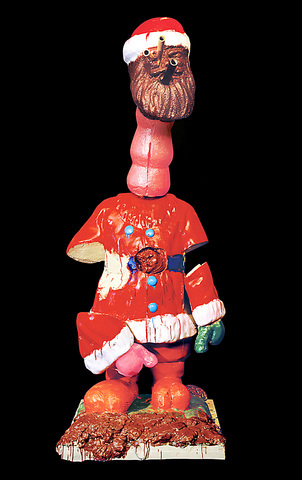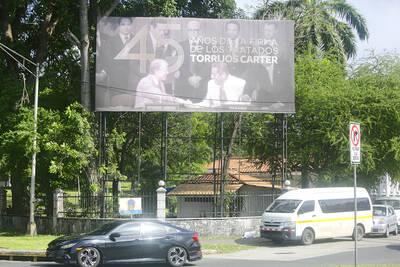Princess Gloria von Thurn und Taxis likes motorcycles and rock stars, lavish parties and jewels. She is known among the international jet set as the "punk princess" who collects contemporary art.
But sometimes, she cleans house.
On Monday night she put 50 works by some of today's trendiest artists -- including Jeff Koons, Richard Prince, Cindy Sherman and Paul McCarthy -- up for sale at Phillips, de Pury & Co (Phillips auctioned 85 more works from her collection Tuesday.)

PHOTO: NY TIMES NEWS SERVICE
The sale totaled US$6.3 million, or US$7.4 million with Phillips' commission. (Prices of record include the commission: 20 percent of the first US$200,000 of the hammer price and 12 percent of the rest. Estimates do not reflect commissions.) The high estimate was US$7 million.
In 1993 the princess held a nine-day sale of furniture, art and objects from Schloss St. Emmeram, the family castle in Regensburg, Bavaria -- everything from a Harley-Davidson motorcycle to 75,000 bottles of vintage wine. That sale, which brought more than US$19 million, went to pay inheritance taxes on the estate of her husband, Prince Johannes, who died in 1990. In 1992 she sold much of the family jewels, also at Sotheby's. Simon de Pury, chairman of Phillips, then chairman of Sotheby's in Europe, presided over both events, and he and the princess became friends.
De Pury recently put her on Phillips' board. And on Monday night she showed her support for him and for the company by weeding out much of her collection. (Art dealers familiar with her collection say she has held on to the best work.) Before the auction, some dealers grumbled that the princess had bought many of the works recently in anticipation of turning them around at this auction to make a profit. Many also said the offerings were mediocre in quality. But that didn't seem to diminish the enthusiasm for contemporary art; even works made just months ago sold for strong prices. Records were set for eight artists.
Still, no single item made US$1 million. The most expensive work was Paul McCarthy's Santa Long Neck, a 2004 painted bronze sculpture of a distorted Santa Claus. It sold to a telephone bidder for US$856,000, over its US$700,000 high estimate and a record for the artist at auction.
There was less competition for Koons' Yorkshire Terriers, a polychromed wood sculpture of two dogs, one wearing a blue bow, the other a pink one. It is from an edition of three plus an artist's proof that Koons made in 1991. Only one bidder wanted the sculpture, and the hammer fell at US$550,000, just under the low estimate of US$600,000. Sometimes there was serious competition. The princess was selling two joke paintings -- plain-colored canvases from the 1980s with the text of jokes -- by Richard Prince, whose prices have skyrocketed over the last two years. Stellan Holm, a Manhattan dealer, and Hyun Sook Lee, president of the Kukje Gallery, one of the most successful galleries in Seoul, South Korea, fought over Untitled (A Man Walks into a Doctor's Office), from 1988. Both wanted the painting badly, and the winner was Lee, who paid US$475,200, far above its US$350,000 high estimate.
Prince's Why Are You Crying? (1988) was less popular and less expensive. Todd Levin, the curator for the Manhattan collector Adam Sender, bought it for US$296,000, above its low estimate of US$250,000.
The way even brand-new works sold surprised many dealers and collectors. Anselm Kiefer's 2005 sculpture XXI Claudia Quinta, made of lead books stacked precariously and topped with a model ship and human hair, was bought by James Cohan, the Manhattan dealer, for US$340,800, far above its high estimate of US$300,000.
After the sale, de Pury said it did not represent the end of the princess' collecting. "It is her intention," he said, "to keep buying art that is right now."

April 14 to April 20 In March 1947, Sising Katadrepan urged the government to drop the “high mountain people” (高山族) designation for Indigenous Taiwanese and refer to them as “Taiwan people” (台灣族). He considered the term derogatory, arguing that it made them sound like animals. The Taiwan Provincial Government agreed to stop using the term, stating that Indigenous Taiwanese suffered all sorts of discrimination and oppression under the Japanese and were forced to live in the mountains as outsiders to society. Now, under the new regime, they would be seen as equals, thus they should be henceforth

Last week, the the National Immigration Agency (NIA) told the legislature that more than 10,000 naturalized Taiwanese citizens from the People’s Republic of China (PRC) risked having their citizenship revoked if they failed to provide proof that they had renounced their Chinese household registration within the next three months. Renunciation is required under the Act Governing Relations Between the People of the Taiwan Area and the Mainland Area (臺灣地區與大陸地區人民關係條例), as amended in 2004, though it was only a legal requirement after 2000. Prior to that, it had been only an administrative requirement since the Nationality Act (國籍法) was established in

Three big changes have transformed the landscape of Taiwan’s local patronage factions: Increasing Democratic Progressive Party (DPP) involvement, rising new factions and the Chinese Nationalist Party’s (KMT) significantly weakened control. GREEN FACTIONS It is said that “south of the Zhuoshui River (濁水溪), there is no blue-green divide,” meaning that from Yunlin County south there is no difference between KMT and DPP politicians. This is not always true, but there is more than a grain of truth to it. Traditionally, DPP factions are viewed as national entities, with their primary function to secure plum positions in the party and government. This is not unusual

US President Donald Trump’s bid to take back control of the Panama Canal has put his counterpart Jose Raul Mulino in a difficult position and revived fears in the Central American country that US military bases will return. After Trump vowed to reclaim the interoceanic waterway from Chinese influence, US Defense Secretary Pete Hegseth signed an agreement with the Mulino administration last week for the US to deploy troops in areas adjacent to the canal. For more than two decades, after handing over control of the strategically vital waterway to Panama in 1999 and dismantling the bases that protected it, Washington has